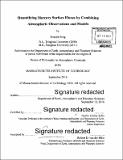| dc.contributor.advisor | Noelle Eckley Selin. | en_US |
| dc.contributor.author | Song, Shaojie. Massachusetts Institute of Technology | en_US |
| dc.contributor.other | Massachusetts Institute of Technology. Department of Earth, Atmospheric, and Planetary Sciences. | en_US |
| dc.date.accessioned | 2017-02-22T19:03:51Z | |
| dc.date.available | 2017-02-22T19:03:51Z | |
| dc.date.copyright | 2016 | en_US |
| dc.date.issued | 2016 | en_US |
| dc.identifier.uri | http://hdl.handle.net/1721.1/107107 | |
| dc.description | Thesis: Ph. D. in Atmospheric Chemistry, Massachusetts Institute of Technology, Department of Earth, Atmospheric, and Planetary Sciences, 2016. | en_US |
| dc.description | Cataloged from PDF version of thesis. | en_US |
| dc.description | Includes bibliographical references (pages 115-134). | en_US |
| dc.description.abstract | Mercury (Hg) is a critical environmental concern. Although an important component of its biogeochemical cycle, large uncertainties still exist in the estimates of surface fluxes of mercury. Three projects presented in this thesis improve our understanding of mercury surface fluxes at different spatial scales by combining atmospheric observations and models. First, a global scale inverse model study uses observations at multiple ground-based stations and simulations from a three-dimensional chemical transport model (GEOS-Chem) to obtain a total mercury emission of about 5.8 Gg yr-¹, in which the ocean contributes about a half. The global terrestrial ecosystem is found to be neither a net source nor a net sink of Hg⁰ (gaseous elemental mercury). The optimized Asian anthropogenic emissions (0.7-1.8 Gg yr-¹) are very likely higher than bottom-up estimates, implying missing sources, higher activity levels, and/or lower control efficiencies in these inventories. Optimizing two physicochemical ocean parameters improves the model's ability in reproducing the seasonal pattern of observed Hg⁰. The inversion also suggests that the legacy mercury releases tend to reside in the terrestrial system rather than in the ocean. Second, the comparison of nested grid GEOS-Chem model simulations with aircraft observations support results from the global inversion, and further suggests that the Northwest Atlantic Ocean is a net source of Hg⁰, with high evasion fluxes in summer (related to the high precipitation rates and deposition fluxes of oxidized mercury), whereas the terrestrial ecosystem in the eastern United States is likely a net sink of Hg⁰ during summer. Third, a one-dimensional chemical transport model is built and used to simulate the mercury diurnal variabilities observed at Dome Concordia on the Antarctic plateau. The model simulation best reproducing the Hg⁰ observations shows that in summer mercury is rapidly cycled between the shallow atmospheric boundary layer and the surface snowpack. A two-step bromine initiated scheme oxidizes Hg⁰ Oxidized mercury is deposited, photoreduced in the surface snow, and reemitted as Hg⁰ back into the atmosphere. | en_US |
| dc.description.statementofresponsibility | by Shaojie Song. | en_US |
| dc.format.extent | 134 pages | en_US |
| dc.language.iso | eng | en_US |
| dc.publisher | Massachusetts Institute of Technology | en_US |
| dc.rights | MIT theses are protected by copyright. They may be viewed, downloaded, or printed from this source but further reproduction or distribution in any format is prohibited without written permission. | en_US |
| dc.rights.uri | http://dspace.mit.edu/handle/1721.1/7582 | en_US |
| dc.subject | Earth, Atmospheric, and Planetary Sciences. | en_US |
| dc.title | Quantifying mercury surface fluxes by combining atmospheric observations and models | en_US |
| dc.type | Thesis | en_US |
| dc.description.degree | Ph. D. in Atmospheric Chemistry | en_US |
| dc.contributor.department | Massachusetts Institute of Technology. Department of Earth, Atmospheric, and Planetary Sciences | |
| dc.identifier.oclc | 971494816 | en_US |
